Comparative Evaluation on Combustion and Emission Characteristics of a Diesel Engine Fueled with Crude Palm Oil Blends
Abstract
:1. Introduction
2. Materials and Methods
2.1. Test Fuels
2.2. Test Method
2.3. Error and Uncertainty Analysis
3. Results and Discussions
3.1. Combustion Characteristics
3.1.1. In-Cylinder Pressure
3.1.2. Heat Release Rate
3.1.3. Engine Performance
3.2. Emission Characteristics
3.2.1. CO Emission
3.2.2. HC Emission
3.2.3. NOx Emissions
3.2.4. Smoke Emission
4. Conclusions
- With the increase of palm oil concentration, the in-cylinder pressure and heat release rate (HRR) of most blend fuels are reduced, and the ignition start is delayed.
- Based on the coefficient of variation of the indicated mean effective pressure (COVimep), most of the tested fuels are lower than 2.5%, which indicates that this diesel engine can run all the blend ratios of palm oil without any operating problems. However, based on the high density, high viscosity and low calorific value of palm oil, burning diesel-CPO blends lead to the increase of brake specific fuel consumption (BSFC).
- HC, NOx and smoke opacity are reduced simultaneously when the diesel engine burning diesel-CPO blends, compared with diesel, however, CO emission is increased.
- Overall, by comparing the effects of diesel-CPO blends on engine performance, combustion and emission characteristics, it is found that the direct mixing of up to 30% CPO is the most appropriate for this CRDI diesel engine.
Author Contributions
Funding
Institutional Review Board Statement
Informed Consent Statement
Conflicts of Interest
References
- Özener, O.; Yüksek, L.; Ergenç, A.T.; Özkan, M. Effects of soybean biodiesel on a DI diesel engine performance, emission and combustion characteristics. Fuel 2014, 115, 875–883. [Google Scholar] [CrossRef]
- An, H.; Yang, W.; Chou, S.; Chua, K.J. Combustion and emissions characteristics of diesel engine fueled by biodiesel at partial load conditions. Appl. Energy 2012, 99, 363–371. [Google Scholar] [CrossRef]
- Liu, J.; Yang, J.; Sun, P.; Gao, W.; Yang, C.; Fang, J. Compound combustion and pollutant emissions characteristics of a com-mon-rail engine with ethanol homogeneous charge and polyoxymethylene dimethyl ethers injection. Appl. Energy 2019, 239, 1154–1162. [Google Scholar] [CrossRef]
- Jaichandar, S.; Kumar, P.S.; Annamalai, K. Combined effect of injection timing and combustion chamber geometry on the performance of a biodiesel fueled diesel engine. Energy 2012, 47, 388–394. [Google Scholar] [CrossRef]
- Kegl, B. Influence of biodiesel on engine combustion and emission characteristics. Appl. Energy 2011, 88, 1803–1812. [Google Scholar] [CrossRef]
- Suh, H.K.; Lee, C.S. A review on atomization and exhaust emissions of a biodiesel-fueled compression ignition engine. Renew. Sustain. Energy Rev. 2016, 58, 1601–1620. [Google Scholar] [CrossRef]
- Kegl, B. Numerical analysis of injection characteristics using biodiesel fuel. Fuel 2006, 85, 2377–2387. [Google Scholar] [CrossRef]
- Lee, C.S.; Park, S.W.; Kwon, S.I. An experimental study on the atomization and combustion characteristics of biodiesel-blended fuels. Energy Fuels 2005, 19, 2201–2208. [Google Scholar] [CrossRef]
- An, H.; Yang, W.M.; Maghbouli, A.; Li, J.; Chou, S.K.; Chua, K.J. Performance, combustion and emission characteristics of biodiesel derived from waste cooking oils. Appl. Energy 2013, 112, 493–499. [Google Scholar] [CrossRef]
- Raman, L.A.; Deepanraj, B.; Rajakumar, S.; Sivasubramanian, V. Experimental investigation on performance, combustion and emission analysis of a direct injection diesel engine fuelled with rapeseed oil biodiesel. Fuel 2019, 246, 69–74. [Google Scholar] [CrossRef]
- Ağbulut, Ü.; Karagöz, M.; Sarıdemir, S.; Öztürk, A. Impact of various metal-oxide based nanoparticles and biodiesel blends on the combustion, performance, emission, vibration and noise characteristics of a CI engine. Fuel 2020, 270, 117521. [Google Scholar] [CrossRef]
- Asokan, M.A.; Prabu, S.S.; Bade, P.K.K.; Nekkanti, V.M.; Gutta, S.S.G. Performance, combustion and emission characteristics of juliflora biodiesel fuelled DI diesel engine. Energy 2019, 173, 883–892. [Google Scholar] [CrossRef]
- Abbaszaadeh, A.; Ghobadian, B.; Omidkhah, M.R.; Najafi, G. Current biodiesel production technologies: A comparative re-view. Energy Convers. Manag. 2012, 63, 138–148. [Google Scholar] [CrossRef]
- Yoosuk, B.; Udomsap, P.; Puttasawat, B.; Krasae, P. Modification of calcite by hydration–dehydration method for hetero-geneous biodiesel production process: The effects of water on properties and activity. Chem. Eng. J. 2010, 162, 135–141. [Google Scholar] [CrossRef]
- Kawashima, A.; Matsubara, K.; Honda, K. Development of heterogeneous base catalysts for biodiesel production. Bioresour. Technol. 2008, 99, 3439–3443. [Google Scholar] [CrossRef]
- Nautiyal, P.; Subramanian, K.A.; Dastidar, M.G.; Kumar, A. Experimental assessment of performance, combustion and emis-sions of a compression ignition engine fuelled with Spirulina platensis biodiesel. Energy 2020, 193, 116861. [Google Scholar] [CrossRef]
- Prabu, S.S.; Asokan, M.; Prathiba, S.; Ahmed, S.; Puthean, G. Effect of additives on performance, combustion and emission behavior of preheated palm oil/diesel blends in DI diesel engine. Renew. Energy 2018, 122, 196–205. [Google Scholar] [CrossRef]
- Uyumaz, A. Combustion, performance and emission characteristics of a DI diesel engine fueled with mustard oil biodiesel fuel blends at different engine loads. Fuel 2018, 212, 256–267. [Google Scholar] [CrossRef]
- Qi, D.H.; Chen, H.; Geng, L.M.; Bian, Y.Z.; Ren, X.C. Performance and combustion characteristics of biodiesel–diesel–methanol blend fuelled engine. Appl. Energy 2010, 87, 1679–1686. [Google Scholar] [CrossRef]
- Yılmaz, I.T.; Gumus, M. Investigation of the effect of biogas on combustion and emissions of TBC diesel engine. Fuel 2017, 188, 69–78. [Google Scholar] [CrossRef]
- Shahabuddin, M.; Liaquat, A.M.; Masjuki, H.H.; Kalam, M.A.; Mofijur, M. Ignition delay, combustion and emission character-istics of diesel engine fueled with biodiesel. Renew. Sustain. Energy Rev. 2013, 21, 623–632. [Google Scholar] [CrossRef]
- Patel, C.; Lee, S.; Tiwari, N.; Agarwal, A.K.; Lee, C.S.; Park, S. Spray characterization, combustion, noise and vibrations inves-tigations of Jatropha biodiesel fuelled genset engine. Fuel 2016, 185, 410–420. [Google Scholar] [CrossRef]
- Bari, S.; Lim, T.; Yu, C. Effects of preheating of crude palm oil (CPO) on injection system, performance and emission of a diesel engine. Renew. Energy 2002, 27, 339–351. [Google Scholar] [CrossRef]
- Gharehghani, A.; Mirsalim, M.; Hosseini, R. Effects of waste fish oil biodiesel on diesel engine combustion characteristics and emission. Renew. Energy 2017, 101, 930–936. [Google Scholar] [CrossRef]
- Ge, J.C.; Kim, H.Y.; Yoon, S.K.; Choi, N.J. Optimization of palm oil biodiesel blends and engine operating parameters to improve performance and PM morphology in a common rail direct injection diesel engine. Fuel 2020, 260, 116326. [Google Scholar] [CrossRef]
- Sheng, Y.; Brindhadevi, K.; Eed, E.M.; Xia, C.; Chi, N.T.L. Enzymatic lipase-based methyl esterified Citrullus colocynthis L. biodiesel for improved combustion, performance and emission characteristics. Fuel 2022, 307, 121899. [Google Scholar] [CrossRef]
- Keskin, A.; Şen, M.; Emiroğlu, A.O. Experimental studies on biodiesel production from leather industry waste fat and its effect on diesel engine characteristics. Fuel 2020, 276, 118000. [Google Scholar] [CrossRef]
- Li, L.; Wang, J.; Wang, Z.; Xiao, J. Combustion and emission characteristics of diesel engine fueled with diesel/biodiesel/pentanol fuel blends. Fuel 2015, 156, 211–218. [Google Scholar] [CrossRef]
- Altın, R.; Çetinkaya, S.; Yücesu, H.S. The potential of using vegetable oil fuels as fuel for diesel engines. Energy Convers. Manag. 2001, 42, 529–538. [Google Scholar] [CrossRef]
- Yilmaz, N.; Atmanli, A.; Vigil, F.M. Quaternary blends of diesel, biodiesel, higher alcohols and vegetable oil in a compression ignition engine. Fuel 2018, 212, 462–469. [Google Scholar] [CrossRef]
- Appavu, P.; Ramanan, M.V.; Venu, H. Quaternary blends of diesel/biodiesel/vegetable oil/pentanol as a potential alternative feedstock for existing unmodified diesel engine: Performance, combustion and emission characteristics. Energy 2019, 186, 115856. [Google Scholar] [CrossRef]
- Varatharajan, K.; Cheralathan, M. Influence of fuel properties and composition on NOx emissions from biodiesel powered diesel engines: A review. Renew. Sustain. Energy Rev. 2012, 16, 3702–3710. [Google Scholar] [CrossRef]
- Leevijit, T.; Prateepchaikul, G. Comparative performance and emissions of IDI-turbo automobile diesel engine operated using degummed, deacidified mixed crude palm oil–diesel blends. Fuel 2011, 90, 1487–1491. [Google Scholar] [CrossRef]
- Silitonga, A.; Masjuki, H.; Ong, H.C.; Sebayang, A.; Dharma, S.; Kusumo, F.; Siswantoro, J.; Milano, J.; Daud, K.; Mahlia, T.M.I.; et al. Evaluation of the engine performance and exhaust emissions of biodiesel-bioethanol-diesel blends using kernel-based extreme learning machine. Energy 2018, 159, 1075–1087. [Google Scholar] [CrossRef]



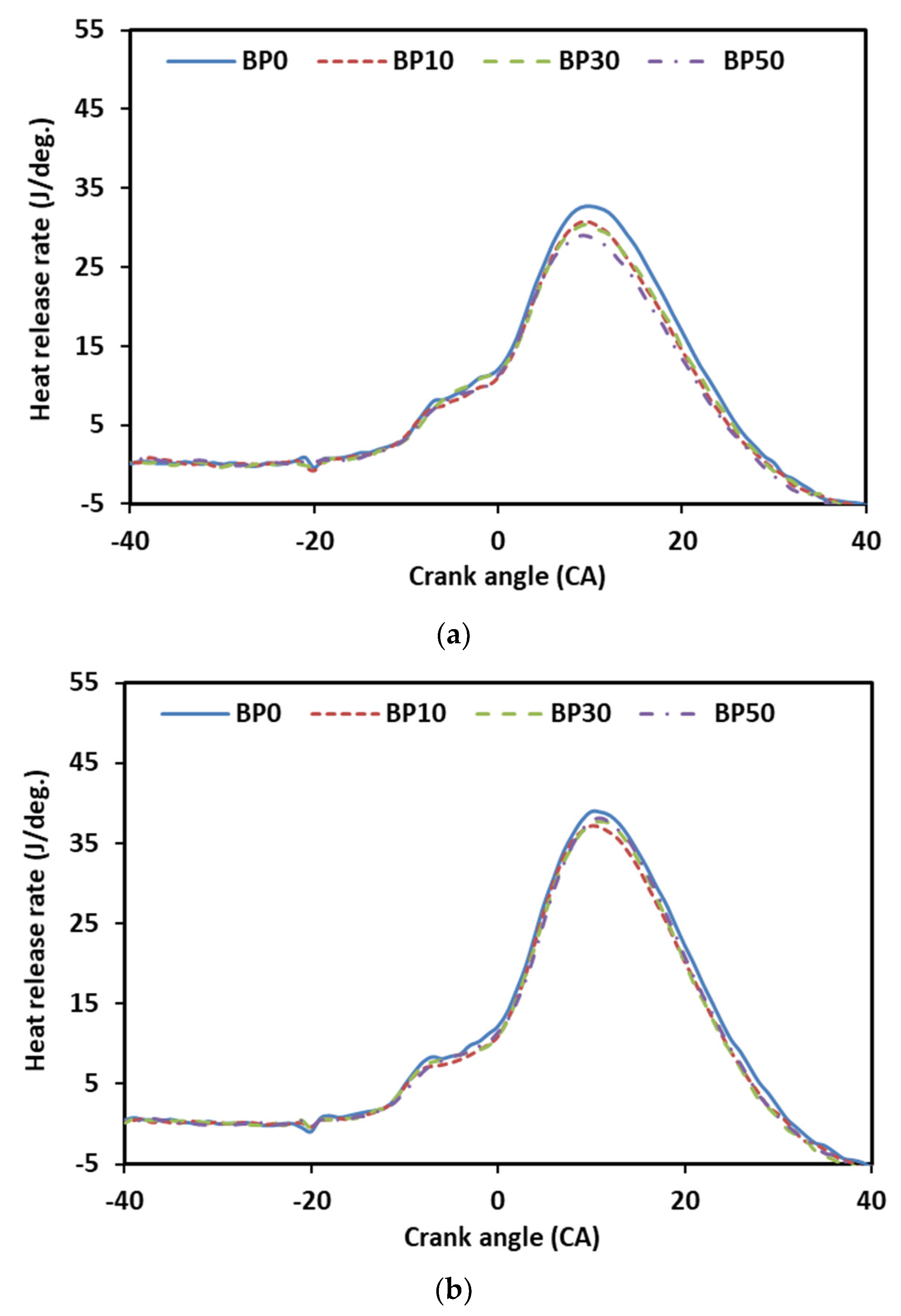
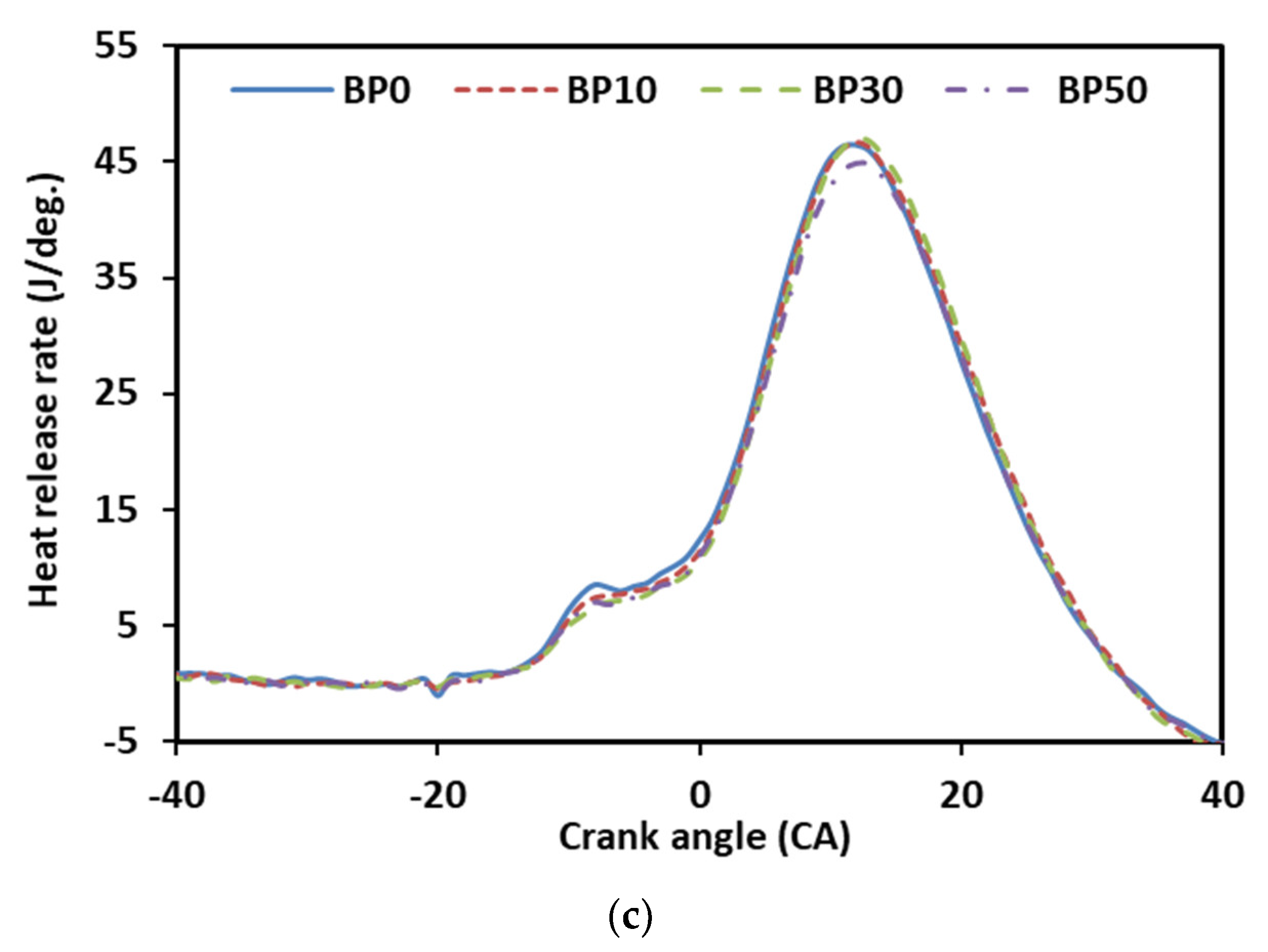
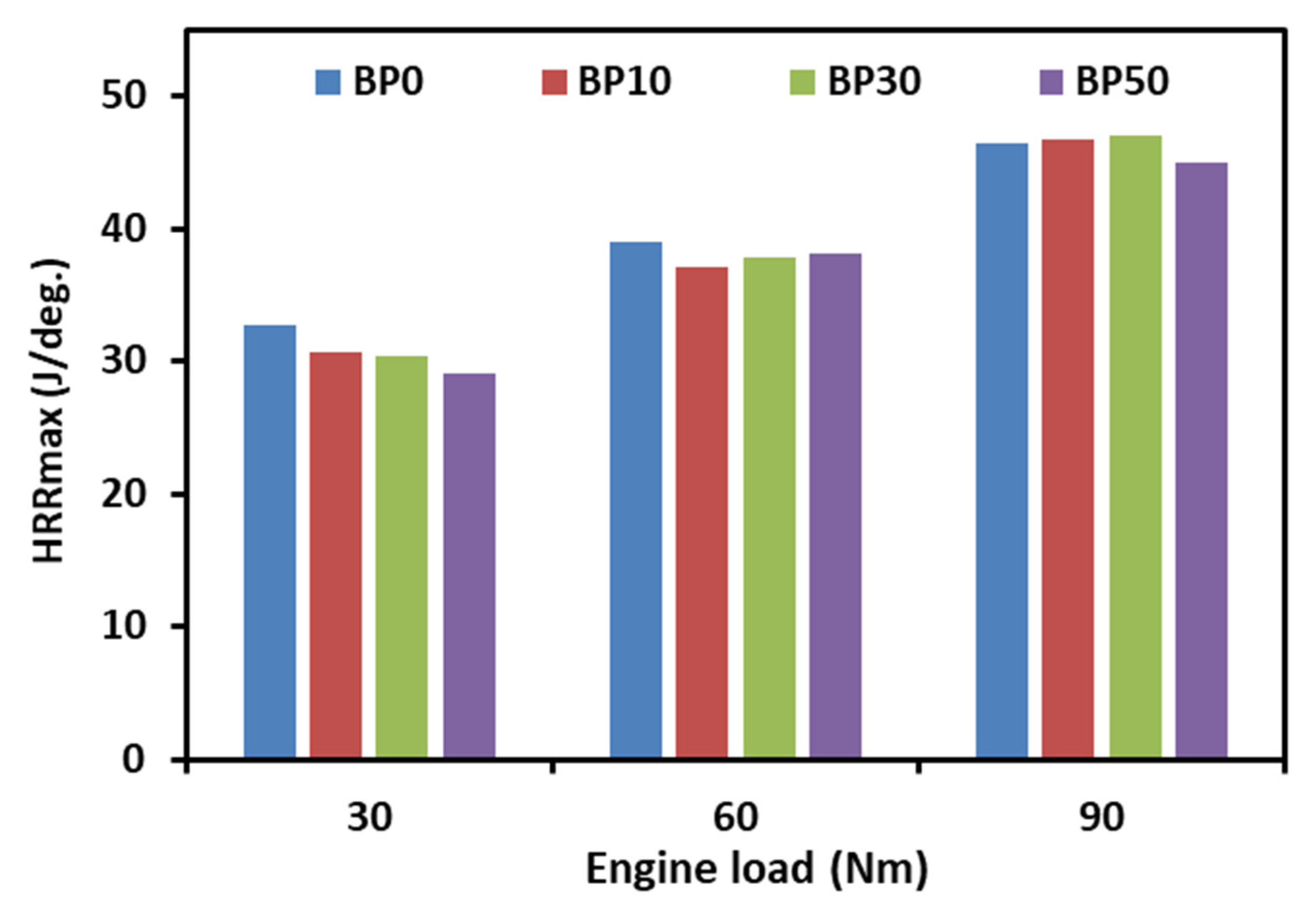
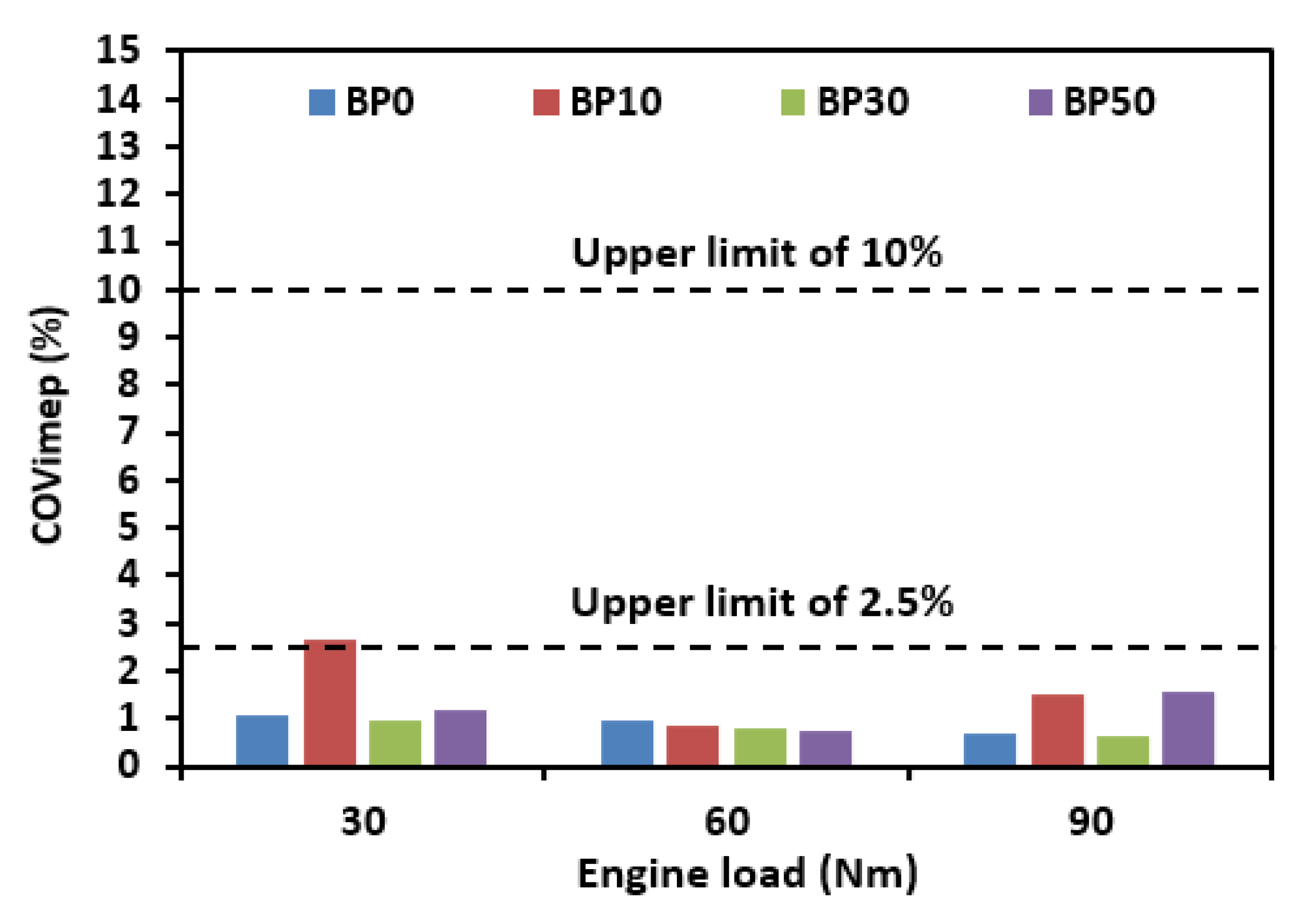
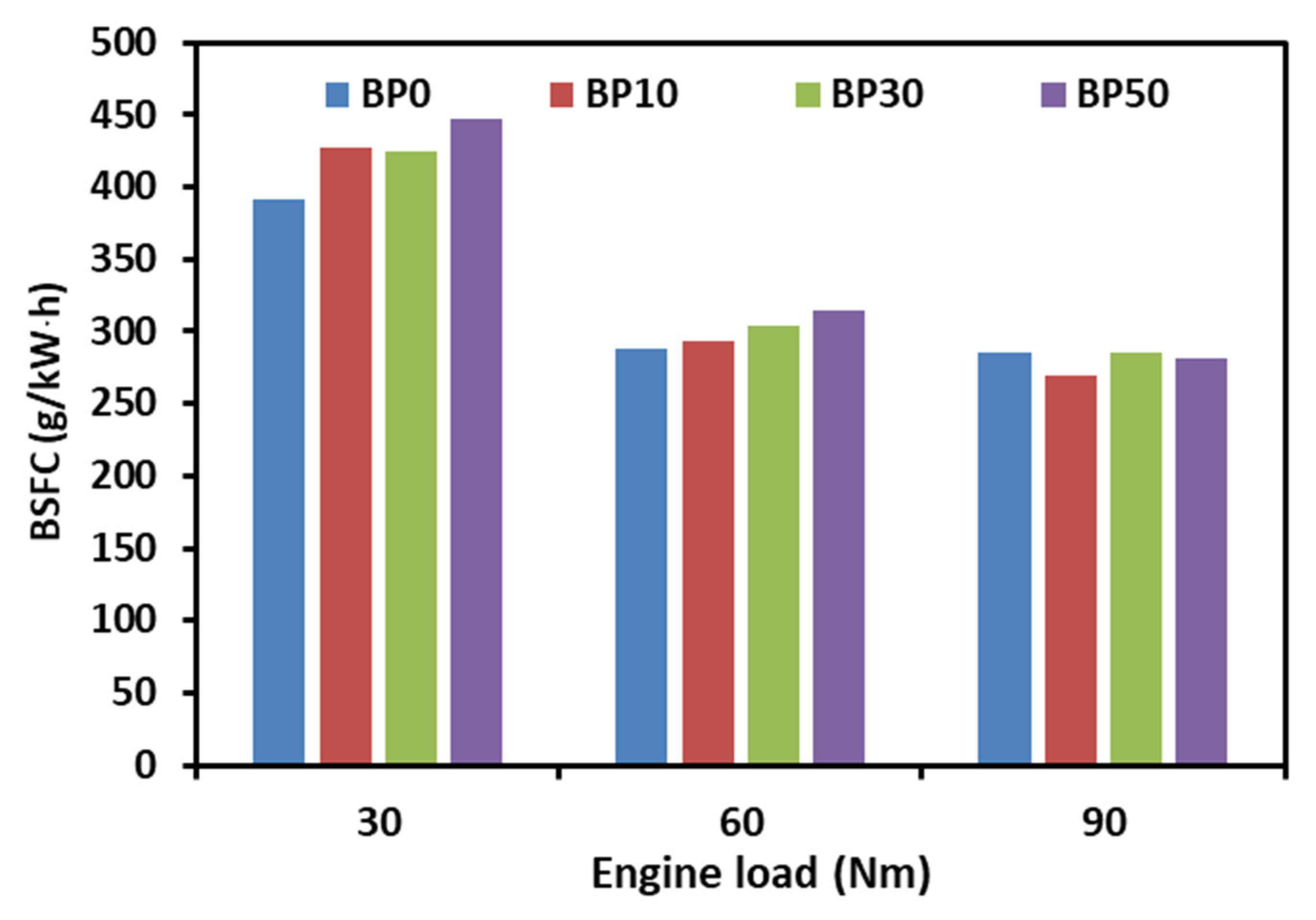
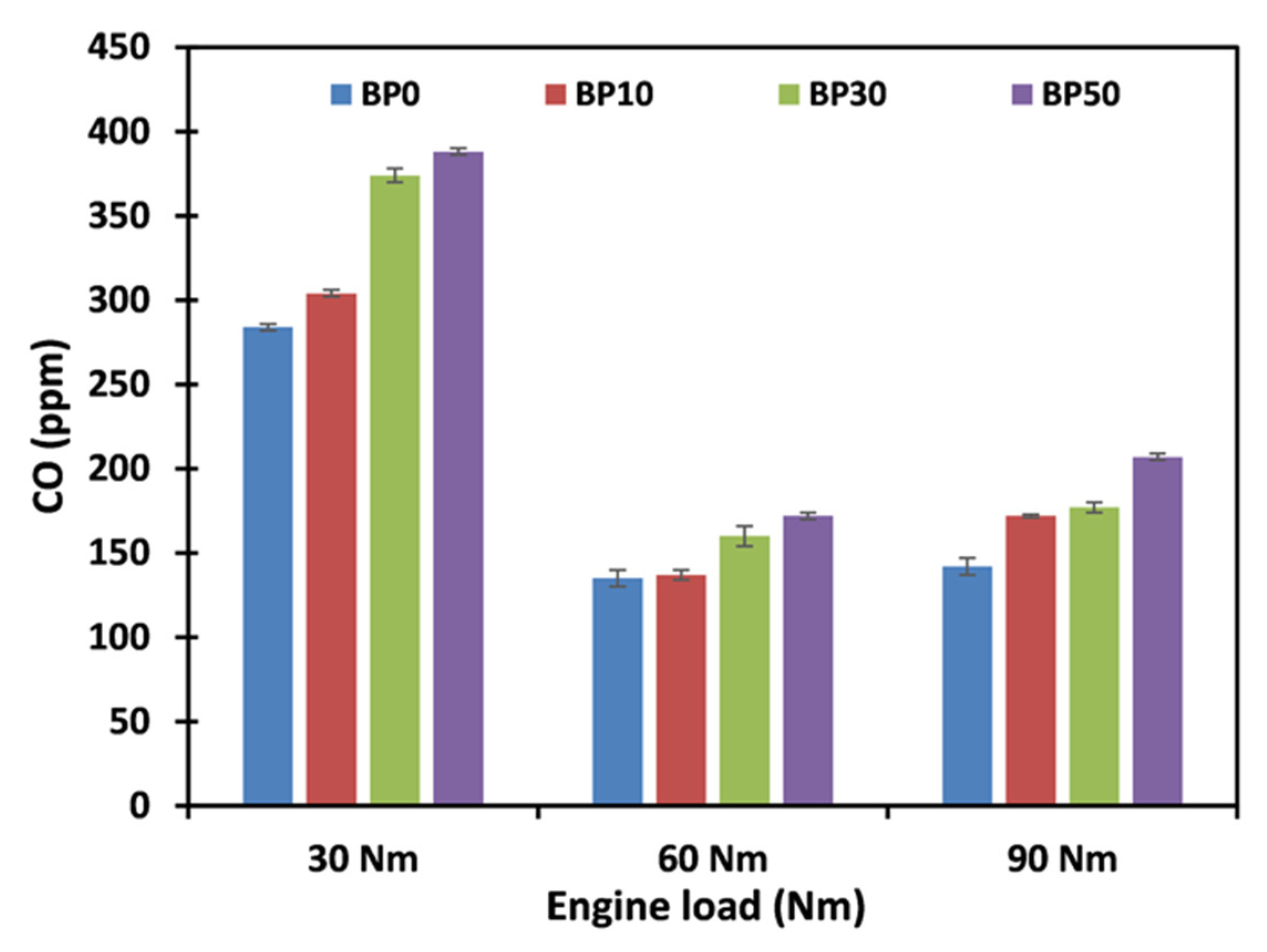


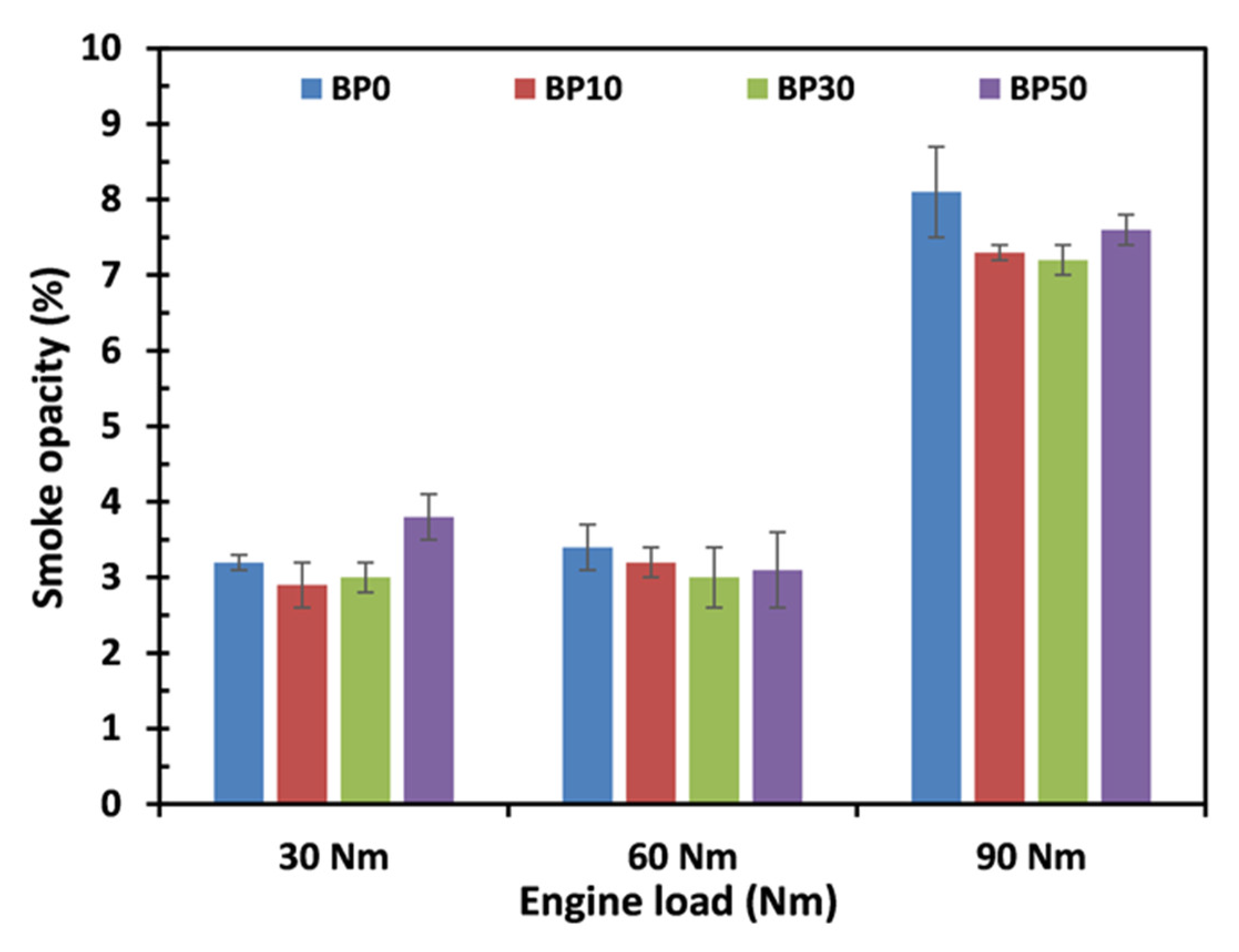
| Properties (Units) | Diesel Fuel | Crude Palm Oil |
|---|---|---|
| Density (kg/m3 at 15 °C) | 836.8 | 903.8 |
| Viscosity (mm2/s at 40 °C) | 2.719 | 42.21 |
| Calorific value (MJ/kg) | 43.96 | 39.34 |
| Cetane index | 55.8 | 49 |
| Flash point (°C) | 55 | 260 |
| Oxygen content (%) | 0 | 11.4 |
| Engine Parameter | Units | Specifications |
|---|---|---|
| Type | - | turbocharged CRDI diesel engine |
| Number of cylinders | - | 4 |
| Bore × stroke | mm | 83 × 92 |
| Injector hole diameter | mm | 0.17 |
| Compression ratio | - | 17.7:1 |
| Max. power | kW/rpm | 82/4000 |
| Item | Conditions |
|---|---|
| Test fuels | BP0, B10, B30, B50 |
| Engine load | 30, 60, 90 Nm |
| Engine speed | 1500 rpm |
| Fuel injection pressure | 45 MPa |
| Pilot injection timing | 22° BTDC |
| Main injection timing | 7° BTDC |
| Intake air temperature | 25 ± 3 °C |
| Cooling water temperature | 85 ± 3 °C |
| Parameter | Accuracy |
|---|---|
| CO (ppm) | ±0.62% |
| NOx (ppm) | ±0.25% |
| HC (ppm) | ±5% |
| Smoke opacity (%) | ±1% |
| Load monitoring (Nm) | ±0.2% |
| Speed measuring (rpm) | ±5 |
| Fuel consumption (g) | ±2 |
| Fuel injection pressure (bar) | ±1 |
| Intake air temperature (°C) | ±3 |
| Cooling water temperature (°C) | ±3 |
Publisher’s Note: MDPI stays neutral with regard to jurisdictional claims in published maps and institutional affiliations. |
© 2021 by the authors. Licensee MDPI, Basel, Switzerland. This article is an open access article distributed under the terms and conditions of the Creative Commons Attribution (CC BY) license (https://creativecommons.org/licenses/by/4.0/).
Share and Cite
Ge, J.C.; Yoon, S.K.; Song, J.H. Comparative Evaluation on Combustion and Emission Characteristics of a Diesel Engine Fueled with Crude Palm Oil Blends. Appl. Sci. 2021, 11, 11502. https://doi.org/10.3390/app112311502
Ge JC, Yoon SK, Song JH. Comparative Evaluation on Combustion and Emission Characteristics of a Diesel Engine Fueled with Crude Palm Oil Blends. Applied Sciences. 2021; 11(23):11502. https://doi.org/10.3390/app112311502
Chicago/Turabian StyleGe, Jun Cong, Sam Ki Yoon, and Jun Hee Song. 2021. "Comparative Evaluation on Combustion and Emission Characteristics of a Diesel Engine Fueled with Crude Palm Oil Blends" Applied Sciences 11, no. 23: 11502. https://doi.org/10.3390/app112311502






